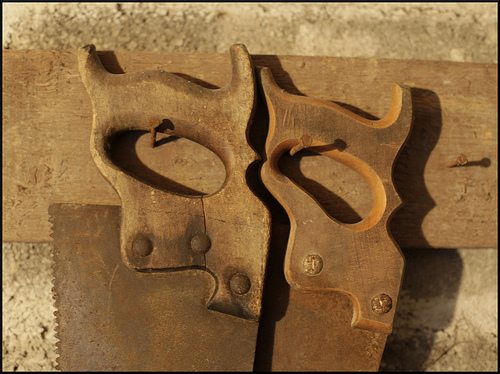All of us find it increasingly difficult to communicate without relying on the ever-expanding jargon of the work place. A friend recently posted this graphic from The Atlantic listing popular office jargon. It’s a good summary of the usual suspects. One alternative to jargon is to dust off some of your favorite analogies and adages. Here are a few that play on the theme of tools. Share your favorites in the reply and comment section of the blog and we can put together a full tool box.

When I was first learning carpentry, I tended to complain to my father that we needed better tools. I had a tendency to blame the tools for my mistakes and justified myself by saying that the work was only as good as the tools. When I threw down a hand saw one day in exasperation and berated it for my less than straight line cut, my father looked over at what I was doing and said, “There are some saws no one can saw straight with.” After a pause, he then said, “And there are some folks who can’t saw straight with any saw.” He left to me to figure out which observation was applicable in my case. I have found this one adage worth a score of HR platitudes about competencies, skills mix, and high potential.
Moving from saws to hammers, I have always reserved a special admiration and appreciation for people who can look at a problem and discern that the solution resides outside their own speciality. It is the remarkable architect who can help a couple see that building a new house won’t heal a troubled marriage. We all have a tendency to do what we are good at doing rather than what needs to be done. I have always liked Maslow‘s adage (often attributed to Mark Twain) that summarizes this problem nicely: “if the only tool you have is a hammer, you tend to see every problem as a nail.” My own bias is that one of the best cures for the “hammer problem” is to get a liberal arts education before you specialize. These days, the hammer and nail problem is also a good reason to make sure you reach beyond your own filtered google search bubble to read things you don’t normally read to discover other tools and problems.
And moving from hammers to knives and other sharp instruments, there is the importance of maintaining an edge. As anyone who has used an ax, a chisel, or even a paring knife can tell you, dull tools are often the most dangerous. When tools are not sharp, we have a tendency to compensate with brute force which often results in a broken tool or injury to someone in its path. When our own wits are dulled, we sometimes become a danger to ourselves and others. I have also found that it is wise, when I have just sharpened one of the tools in the box that has been dull for a long time, to let others know that it is now sharp.
What tool analogies and adages would you add to the toolbox for communicating in the workplace?
